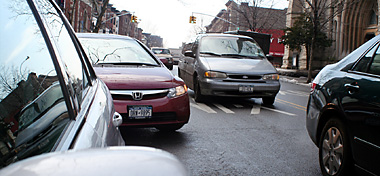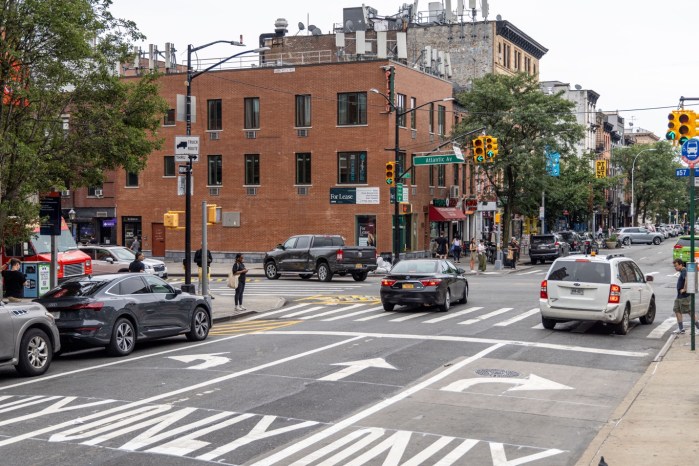The mystery of Park Slope’s congested shopping strip has been solved: Nearly half of the cars on Seventh Avenue are simply looking for parking, a new study shows.
And one solution is to raise the cost of meters, says Transportation Alternatives, a cycling and transit advocacy group.
“The curb is full,” said Paul Steely White, the group’s executive director, who wisely biked to Tuesday’s press conference.
White said the lack of parking spaces along the neighborhood’s commercial spine is actually the cause of substantial traffic.
The TA study found that 45 percent of cars on Seventh Avenue during the day are looking for a spot. White said that parking is so hard to come by because it’s too cheap, resulting in an almost 100-percent occupancy at the meters.
“We need to raise prices until a vacancy rate [of one to two cars per block] is achieved,” he said.
Perhaps the setting of the press conference — a street corner in the People’s Republic of Park Slope — inspired White to liken the situation to Soviet times.
“What we have now is equivalent to a Russian breadline — except instead of peasants lining up for bread, it’s cars driving around for parking,” he said.
Steely refused to touch the third rail of New York City transportation and name an optimal price for the meters, which currently charge just 50 cents for an hour of parking.
“The concept is to inch up the price until you get the right vacancy rate,” he said. “Doubling the cost of parking might deter a lot of people from driving. It’s trial and error.”
The other part of the experiment, he said, was to insure that parking did not become so expensive that drivers would be deterred from making a quick stop at their local store.
White said his group had already reached out to Seventh Avenue businesses to devise a solution together rather than have Transportation Alternatives make recommendations that lack the support of the business community it seeks to help.
A first step, he said, would be to install electronic Muni-Meters, which could be programmed to create “peak” and “off-peak” prices that would create a disincentive to drive during the busiest time of the day.
The TA report, “No Vacancy: Park Slope’s Parking Problem and How to Fix It,” also renewed calls for the city to sell residential parking permits so that local drivers would have first crack at a spot. Such permits don’t guarantee spots, but are akin to a “hunting license” that outsiders don’t have.
“Permits would discourage people from driving into Park Slope,” White said. “The same phenomenon happens in Downtown Brooklyn and Manhattan. Eighty percent of these drivers have a transit option.”
The Department of Transportation has a well-stated antipathy towards residential parking permits.
“We received the report and we’ll review its findings,” said DOT spokeswoman Kay Sarlin. “But we believe that a residential parking program would be problematic because many neighborhoods are very dense and there are many more cars then there is available curb space.”
The Downtown business establishment has taken a similar view of a proposed permit system for the congested areas around the courthouses and in neighboring Fort Greene, where parking places are as hard to find as a forgiving meter maid.
A study commissioned last year by the Downtown Brooklyn Partnership showed that at any given time, Fort Greene has 1,759 cars trolling for 1,089 spots, while Boerum Hill has 1,996 cars looking for 1,769 spots, the parking permit study showed.
Like the latest Transportation Alternative’s study, that report also showed that driving around and looking for parking causes “significant” traffic congestion itself.
The findings were used as a way of rejecting, not promoting, residential permits.
“There are too many cars and not enough spots, with or without permits,” Downtown Brooklyn Partnership Executive Director Michael Burke said at the time.
But Councilman David Yassky (D-Brooklyn Heights) remains a steadfast believer in the permit system, which is used in Chicago, Boston and in Washington, DC, where Yassky once lived.
He cited permits as one part of a multi-pronged solution to traffic that includes more express busses and better mass transit — steps he said must be taken before the Nets basketball arena is completed in time for the fall, 2009 tipoff.
“It is common sense,” said Yassky. “We have to discourage driving to the arena. Even under the best circumstances, thousands of cars will clog these streets on game nights.”
The Transportation Alternatives report was hardly a surprise to Park Slope drivers, who are accustomed to driving around for 10 or 20 minutes to find a spot.
“I sold a four-year-old car a few years ago that had 16,000 miles on it — all of them from driving around looking for parking,” said Leslie Frishberg.
The neighborhood has a long and troubled relationship to the automobile. No wonder that the 2005 film, “The Squid and the Whale,” which was set in Park Slope of the 1970s, had a subplot about the endless search for a parking space.
“We don’t have a parking problem in Park Slope,” joked Jack Frishberg, Leslie’s husband. “There’s no parking, so no problem.”
The report was a hot topic in all the local papers — but mostly for affording reporters the rare chance to refer to themselves (albeit in the third person). A New York Post scribe reported that he “drove around 23 minutes to find a spot” and ended up “eight blocks from his target destination.”
A Brooklyn Paper reporter had no such problem — he doesn’t drive to assignments in the borough. He lives here.























